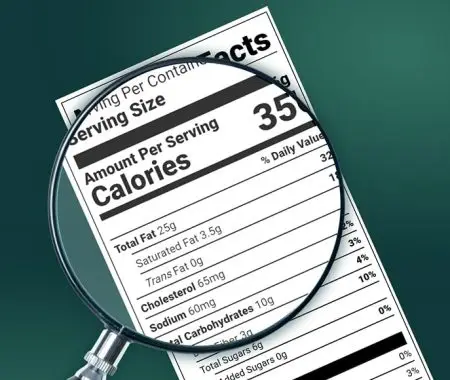In the European Union (EU), understanding tolerances in nutrition labeling is crucial for food and beverage businesses that want to remain compliant and maintain trust with their consumer base. Tolerances in nutrition labeling, according to the European Commission (EC), are the variations between what is stated on a food product’s nutrition label and the actual nutritional content of the food product itself.
These regulations are not just technical details, they are essential for protecting consumers and ensuring that there are fair labeling practices across the EU market. By grasping the nuances of these tolerances, companies can better navigate the complexities of food labeling and avoid legal pitfalls by ensuring their products meet set EU standards. This article will explore what tolerances are, why they matter, and how they impact both businesses and consumers in the realm of EU nutrition labeling.
TLDR
- Defining Tolerances: Tolerances in nutrition labeling represent the acceptable differences between the nutrient contents listed on a product’s label and the actual contents within the product. These variances account for natural variations and measurement inaccuracies during production and testing.
- Consumer Protection: Setting tolerances ensures that labels accurately reflect the food’s nutritional content, helping people, especially those with specific dietary needs, make informed food choices.
- Scientific and Legal Foundations: The methodology for determining tolerances in the EU is grounded in both scientific analysis and legal frameworks. Statistical methods assess natural nutrient variability, while EU regulations provide the legal basis for tolerance settings, ensuring consistency and compliance across member states.
- Added Nutrients: Special attention is given to added vitamins and minerals because incorrect amounts can affect health. Tolerances ensure these additives are beneficial without being harmful.
- Technological Assistance: Companies like Food LabelMaker help businesses ensure their labels meet EC tolerance requirements efficiently and accurately. They reduce errors, save time, and help maintain compliance with changing regulations.
What Are Tolerances in Nutrition Labelling?
As we have stated, tolerances are defined as the differences between the nutrient content declared on a product’s label and what is actually in the product. Small variations can likely occur during the production process or when measuring the nutrients found in the product, so it is not always possible to be completely precise when it comes to the information presented on a food label.
For example, if a label says a cookie has 100 calories, EU rules allow for a little bit of natural variation. This means the cookie might have slightly more or fewer calories than stated, but this difference is within a range that’s considered acceptable or “tolerant”. These tolerances are there to make sure that companies are being truthful on their labels and aren’t unfairly penalized for natural variations that are hard to control.
Including only measurement uncertainty in the tolerance calculation is also essential. This means that only the natural errors that happen during lab tests of food products are considered. This approach ensures that any differences noted are just about the testing process, not because the ingredients or recipe varied. This is important in keeping food labels honest and making sure they reflect as true a picture as possible of what you’re eating. This way, you can trust that the nutritional information on a package reflects what’s actually in the food and not variations in how manufacturers made or tested it.
See How FoodLabelMaker Can Help You
The Rationale Behind Tolerances
Regulatory bodies establish specific variances or tolerances for nutrient values on food labels to ensure overall food safety and accuracy. Tolerances also take into account the natural variations in food composition due to factors like seasonality, ripeness at harvest, and even the differences in batches of the same food product. It also takes into account the inaccuracies that might occur in the various methods used to analyze food nutrients. Regulators set these tolerances to ensure that the nutritional information on food labels is accurate and reliable, despite the natural variations that can occur. This helps consumers make informed choices about their food based on reliable data.
Protecting Consumer Interests
The nutritional information on food labels must be accurate as people’s health often depends on it. Take, for instance, individuals with specific dietary needs such as diabetics, who must meticulously monitor their sugar intake, or those with heart conditions, who need to limit sodium. With the EC setting strict tolerances, companies need to ensure that the nutritional details provided on their products are reliable. This not only allows consumers to make informed food choices but also holds companies accountable for complying with legal standards. Therefore, knowing exactly what’s in your food isn’t just a preference; for many, it’s a necessity.
Balancing Accuracy and Feasibility
Regulators face the challenge of balancing the need for accurate nutrient information with the practicalities and inevitable errors that come with food production and testing. On one hand, they strive to provide consumers with the most precise information possible so that customers can make the best dietary choices. However, on the other hand, they must acknowledge that there are technical limitations when it comes to nutrient analysis and the natural variability that occurs in food products. Establishing tolerances is ultimately a way to achieve this balance so that regulations are both scientifically accurate and practical for food manufacturers.
Methodology for Determining Tolerances
Setting tolerances for nutritional labels in the EU is a careful balance between science and law. It’s all about ensuring the numbers on the labels match up closely with what’s actually in the food, despite natural variations from batch to batch.
Scientific Basis for Tolerance Limits
Setting tolerance levels is more of an art grounded in science than you might think. It starts with scientists employing statistical methods to gauge the natural variation in nutrient levels in foods. They consider factors like varying growing conditions and differences from one production batch to another. The meticulous nature of these scientists is evident in how they manage food testing. They standardize lab procedures to ensure that every test, no matter when or where it is conducted, is as accurate as the next. These careful steps are ultimately crucial in establishing realistic tolerance levels that truly represent what’s in the food product while accommodating natural variability.
Legal Framework Governing Tolerances
On the legal side, the EC has specific regulations that outline how these tolerances should be set. The main law involved is Regulation (EU) No 1169/2011, which covers general information that must be provided on food labels and sets out how to determine these variances legally. This law, along with other detailed directives, ensures the rules for setting tolerances are clear and consistent across all EU countries. This legal groundwork makes sure that the science behind tolerance levels stands up in court and in the marketplace. This upholds the common thread of keeping food labeling honest and reliable.
Tolerances for Added Vitamins and Minerals
When it comes to added vitamins and minerals in food products, the EU sets specific tolerances to ensure that these enhancements truly benefit consumer health. These tolerances are crucial because they help maintain the balance between providing health benefits and preventing potential harm if consumed in excess.
Importance of Accuracy in Added Nutrients
Getting the levels right for added vitamins and minerals is critical in nutrition labelling. Firstly, it’s about keeping consumers safe. Vitamins and minerals are extremely beneficial in the right amounts but can be harmful if taken in excess. For example, too much Vitamin A can cause health issues such as blurred vision and muscle aches, while too much iron might stop other important nutrients like zinc from being absorbed properly.
Being precise with these vitamin and mineral levels also helps companies stay in line with EC regulations, and for many companies in the industry, sticking to these rules is also a big part of building trust with customers. When people feel confident that what’s on the label is what’s in the food, they’re more likely to stick with a brand. Manufacturers must follow these guidelines closely, so there must be regular testing and quality checks on their products.
Leveraging Technology for Compliance
Ensuring that nutrition labels meet the stringent tolerance requirements set by the EC can be a daunting task for businesses in the industry. This is why utilizing tools and platforms like that offered by Food Label Maker can be extremely helpful. Companies such as theirs are designed to simplify the process of creating nutrition labels and ensure that they meet regulatory standards.
Benefits of Using Automated Tools
Using automated tools for nutrition labeling offers numerous advantages and can significantly enhance a business’s success. Here are a few key benefits of using a platform like Food Label Maker:
- Reduction of Errors: Automated tools minimize human error in calculating and listing nutritional information. They use programmed algorithms to ensure that each value meets the required tolerances, reducing the risk of non-compliance due to inaccuracies.
- Increased Efficiency: Automation speeds up the labeling process. Instead of manually calculating each nutrient’s value, tools like FoodLabelMaker.com can instantly generate precise label content, saving valuable time and resources.
- Brand Consistency: Automated systems create uniformity for product labels in different product lines. This helps your brand and consumer trust, as customers expect the same level of accuracy in all products from a single brand.
- Ease of Updating Labels: Market requirements and regulations are always changing. Automated tools can quickly adjust to new rules and standards which makes it easier for businesses to update their labels without starting from scratch or doing it manually each time.
By using tools like those offered by Food Label Maker, companies can not only meet EC regulations more effectively but also improve their operational efficiency and reliability when it comes to nutrition labeling. Utilizing this technology is key to staying competitive in a market that values both compliance and consumer transparency.



